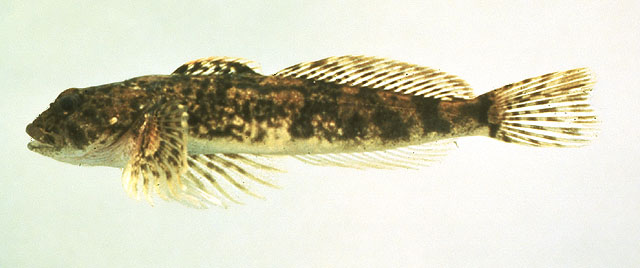| Cottidae (Sculpins) |
| 12.1 cm TL (male/unsexed); max. reported age: 7 years |
|
demersal; freshwater; brackish; depth range 6 - 128 m |
| North America: throughout most of mainland Canada and Alaska; Atlantic Slope drainages south to Potomac River in Virginia, USA; St. Lawrence-Great Lakes basin; upper Mississippi River basin in Wisconsin, Minnesota and Iowa, USA; upper Columbia River drainage in Canada and USA. Also in Siberia, Russia. |
|
Dorsal spines (total): 7-10; Dorsal soft rays (total): 14-19; Anal spines: 0-0; Anal soft rays: 10-14; Vertebrae: 31-35. Distinguished by the two pores on the chin and the short lateral line ending under the second dorsal fin (Ref. 27547). Gill rakers short and stubby, about 6 on first gill arch; lateral line incomplete, ending under middle of soft dorsal fin and usually having a few isolated pores behind this point; main portion with 12 to 26 pores (Ref. 27547). Pectorals large and fan-shaped, tips of lower rays projecting; fourth ray of pelvic much reduced; caudal rounded (Ref. 27547). Rather dark brown or green to dark gray on back and sides, whitish below, with vague, dark mottlings or bars below soft dorsal; belly sometimes with orange tints; soft dorsal, pectoral and caudal fins usually barred, pelvic fins and anal usually immaculate but sometimes barred; spiny dorsal dark at base, with a clear margin that may turn orange in breeding males; breeding males usually dark, sometimes black, all over (Ref. 27547). |
| Inhabits rocky riffles of cold streams, rocky areas of lakes (commonly at 90-106 m depth), springs and their effluents (Ref. 5723). Moves into shallow water to spawn (Ref. 27547). In some areas, they are common in brackish water (Ref. 27843), presumably moving to and from fresh water, at least for spawning (Ref. 27547). Feeds mostly on aquatic insect larvae and nymphs but also on crustaceans, small fishes, and plant materials (Ref. 1998). May be used as bait, but this seems rare (Ref. 27547). |
|
Least Concern (LC); Date assessed: 24 June 2020 Ref. (130435)
|
| harmless |
Source and more info: www.fishbase.org. For personal, classroom, and other internal use only. Not for publication.

